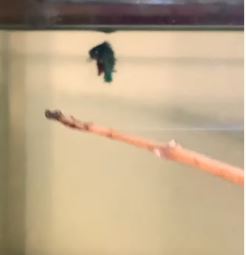Betta fish are not that hardy a fish as you might expect. Even though they have beautiful and vibrant colored fins, they are highly susceptible to diseases and illnesses. One of the most potent diseases that affects a betta fish is the graphite disease.
Graphite disease is a bacterial infection that is quite prevalent in various aquarium fish. It is caused by a bacteria called oodinium that attaches itself to the fish and feeds its body. Fish suffering from graphite disease have difficulty breathing and are characterized by discoloration of fins. You should look for such symptoms as soon as possible for effective treatment of graphite disease in betta fish.
What Is Graphite Disease In Betta Fish?
As stated earlier, graphite disease is a bacterial infection caused by a bacteria called oodinium. Oodinium is a free-flowing microscopic parasite that not only can photosynthesize under light but also can feed off other fish. Oodinium has different stages in which it attacks a fish.
The first stage of oodinium infection comprises of swimming freely in the aquarium water. They live in the water till they have found a good host fish to attach themselves to. The second stage is when the bacteria finds a suitable host fish and attaches itself to the fish’s body, thereby making the fish the source of feeding there.
This cycle can continue infinitely if not treated properly at the right time. These parasites reproduce rapidly under the right conditions. Therefore, it becomes essential for you to identify the problem as early as possible. You should treat your tank water for at least ten days regularly to remove any trace of the bacteria.
If you think your betta fish is affected by graphite disease, you should look for some signs. For instance, if your betta fish is rubbing itself against the tank objects, or if the body of the betta fish appears greenish or brownish, or if your betta fish is gasping for air, then it may be a sign of velvet disease or graphite disease in betta fish.
How To Treat Graphite Diesease in Betta Fish?

If you suspect that your betta fish is suffering from graphite disease, then you need not panic. As long as the symptoms are identified at the right time, then this disease is entirely treatable. There are certain medications and home remedies that you can try to treat graphite disease in betta fish.
Here are some of how you can successfully treat graphite disease in betta fish.
Medication
As mentioned earlier, the oodinium parasite has two stages of affecting a fish. One of them is the free-swimming stage in which the bacteria remains in the tank water as long as it finds a suitable host fish for itself. The second stage is when oodinium finally clings to the body of the fish.
It is quite easy to get rid of the bacteria when they are in the first stage, that is, when they are swimming freely in the tank water. However, it may be difficult to remove the parasites during stage two as they are immune to certain chemicals at the time of this stage.
We also know that the one cycle of the oodinium lasts for about 10 days. Therefore, you need to administer the medication for about 10 days daily to get rid of the bacteria in both stages of the cycle. Make sure to follow the instructions of the medicine manufacturer properly to see the most effective results.
Even after you are able to remove the bacteria from the body of the fish, your betta fish may be susceptible to secondary infections. Therefore, you must also administer certain bacterial and fungal infection treatments in the tank water periodically to prevent such secondary infections.
Do It Yourself (DIY)
You can also try certain home remedies to treat graphite disease in betta fish. You must keep one thing in mind while trying these home remedies, that is, these work only in case of mild bacterial infection and the early stages of the infection. Proper medication must be provided in severe cases.
You can try increasing the water temperature to 82 degrees F. This will disrupt the growth of the oodinium. You can also try dimming the aquarium lights so as to disturb the photosynthesis process of the parasite. These can help hinder the life cycle of the bacteria itself.
You can also add aquarium salt and a solution of copper sulfate in the tank water. This will ensure that the tank water is not suitable for the harmful bacteria to live in. This will disrupt their life cycle, preventing them from attaching themselves to the betta fish’s body.
How To Prevent Graphite Disease In Betta Fish?
Bacterial infections affect only those fish that are already stressed. Thus, it would help to provide a calm and habitable environment for your betta fish. Poor water quality is one of the primary reasons for your betta fish getting stressed.
To ensure good water quality, check the water parameters (water temperature, water pH level, and water hardness) regularly to ensure that they are optimum. Also, conduct periodical water changes of about 20-25% every week for proper water cycling.
Ensure that the betta tank contains all the necessary equipment like a proper filtration system and a water heater. This will ensure that the tank water is absent of any unwanted ammonia, chlorine, and other heavy metals that may cause serious harm to your betta fish.
It would help if you also fed your betta fish a properly nutritious diet. A betta fish is primarily carnivorous and should be fed a diet rich in protein. A balanced diet will ensure your betta fish’s health and safety by promoting immunity.
FAQs on Treating Graphite Disease in Betta Fish
Is graphite disease contagious?
YES. Graphite disease, being a bacterial infection, is highly contagious. It needs to be treated as soon as possible to prevent it from spreading to other fish.
How long does it take to treat graphite disease in betta fish?
One life cycle of the oodinium bacteria lasts for about ten days. Continued treatment for about ten days can treat graphite disease in betta fish. However, it may take weeks, depending on the severity of the disease.
What are the symptoms of graphite disease in betta fish?
If you see your betta fish constantly rubbing itself against the tank objects, having difficulty breathing, or turning into a brownish-green color, then it may be a sign of graphite disease in betta fish.
Final Thoughts
If you feel that your betta fish is suffering from graphite disease, you should look for the visible symptoms. If identified early, graphite disease in betta fish is quite easily treatable. Make sure to keep the tank water clean throughout the process.







